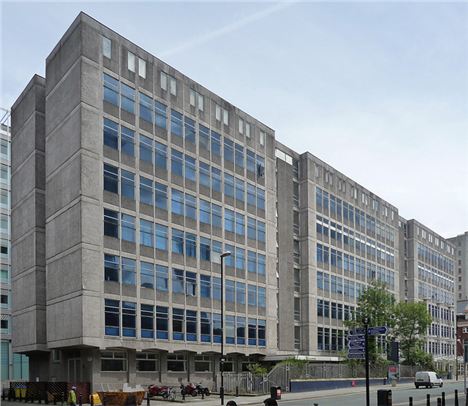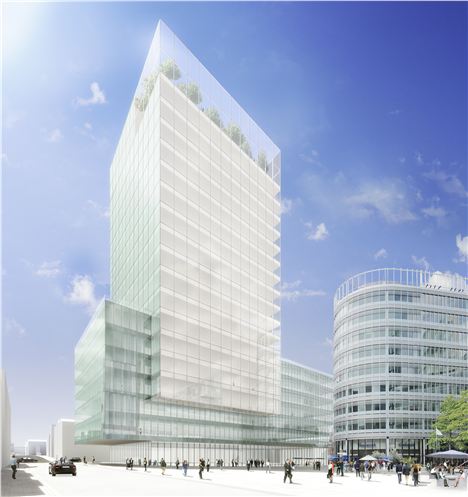PROPERTY developers Allied London have submitted plans for the final phase of their Spinningfields masterplan with the redevelopment of Quay House to become No 1 Spinningfields, a nineteen-storey office building including a skyline restaurant.
“No 1 Spinningfields will be the district’s most imposing building to date and one of Manchester’s most stand-out office buildings."
The new tower, designed by Ian Simpson Architects, will provide 343,000 gross sq ft of office space and connect Quay Street to Hardman Square with a pedestrianized route running through the middle of the ground floor.
Ground floor units will be made available to food, drink and retail outlets.
A decision on planning is expected on 10 April 2014.
Quay House as it is now
Michael Ingall, CEO of Allied London said: “No 1 Spinningfields will be the district’s most imposing building to date and one of Manchester’s most stand-out office buildings. Our last significant building, 3 Hardman Square, won several awards for its design and specification and we expect this building to take the mantle of the best regional office building in the UK.
“The 19th floor restaurant will have a glass-enclosed roof terrace giving patrons unparalleled views of Greater Manchester. In line with our vision for Spinningfields, we aim to secure an operator of the highest calibre to provide a fine dining and mixology experience worthy of such a grand vantage point location.”
High it climbs - impressively too
John Cooper, director at Deloitte Real Estate, the consultancy that compiled and submitted the application, said: “The proposals represent the final piece of the original Spinningfields Masterplan - completing the development with a stunning landmark building.
“A key consideration in the evolution of the design has been the desire to enhance the environment within Hardman Square. The new building will provide a dramatic enclosure to the Square and its form and orientation has been evolved to ensure that direct sunlight is retained within the square at key times of the day including lunch times and evenings.”
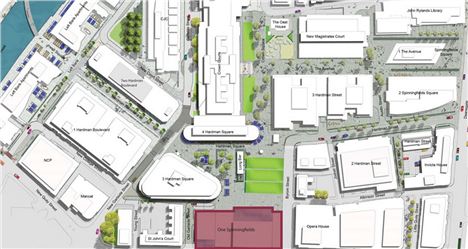 Map with No 1 Spinningfields highlighted
Map with No 1 Spinningfields highlighted
The application comes as Allied London have just been granted the all clear for The Cotton Building, a new ten-floor multi-use development for Spinningfields on the patch of grass opposite RBS.
The developer also continues to work on the redevelopment of ITV’s old thirteen-acre Granada site, an area of the city that Allied London hope will become a ‘new living quarter’ for the city, with vast vacant buildings, studios and warehouses up for grabs.
Ingall has stated that 'The Lawns' in Spinningfields, originally earmarked for development, will remain largely as they are:
"‘The Lawns’ area was destined for future development as part of the original masterplan but the area has become an overwhelming success, much loved by the public. It is now integral to Spinningfields and will be maintained and enhanced, continuing as a special focal point for all kinds of activities.”
Elegy To Quay House
Quay House is one of those sixties buildings that have become derided, abused and thrown in the litter bin of International Modernism, yet, if you look at it objectively, yes, it might be typical of its time, but it is still a building of great subtlety and balance.
The architects are one of the great dynasties of top class Manchester design - HS Fairhurst & Son. The firm still exists as Fairhurst Design Group.
The International Modern style is going through a revival from the sort of people who get nostalgic over vinyl records.
The city would be poorer without the Fairhursts.
Bridgewater House, India House, Lancaster House, Ship Canal House, Rylands Building (now Debenhams) - the list goes on - are all to the designs of HS Fairhurst.
These are key landmarks of the city.
Imagine Manchester without the rows of glittering warehouses along Whitworth Street between Princess Street and Oxford Street. Every visitor I take around the city adores this impressive manmade canyon.
 Quay HouseQuay House was completed between 1964-5 - it's fifty-years-old. Given a scrub it still looks sharp, its sandstone textured concrete panels bold, its eight floors and thirty-eight bays somehow heroic.
Quay HouseQuay House was completed between 1964-5 - it's fifty-years-old. Given a scrub it still looks sharp, its sandstone textured concrete panels bold, its eight floors and thirty-eight bays somehow heroic.
There was a return to classical inspiration in many Modernist buildings, a return to the discipline of a mathematical assembly of massing with a building.
The three (that ancient power of three) protruding bays of Quay House between recessed stair towers recall the design of typical Georgian buildings in Britain - Manchester Art Gallery, Lyme Hall and Cobden House (directly opposite Quay House) are local examples. Just take away the columned protruding centre porticos of these buildings and the basic shapes are similar.
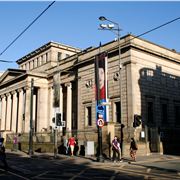 The Art GalleryIn Quay House, the way the ground floor was cut-away delivering a shady overhang - a pillarless arcade - adds another playful Classical air to the whole. It also adds more texture.
The Art GalleryIn Quay House, the way the ground floor was cut-away delivering a shady overhang - a pillarless arcade - adds another playful Classical air to the whole. It also adds more texture.
Quay House is a good sixties building. This may still be an oxymoron but look at it without prejudice and you might see that.
Curiously International Modern buildings are going through a revival in opinion at present - see Phil Griffin's review of Concretopia here - albeit often from the sort of people who get nostalgic over vinyl records. Modernism has in certain circles become as voguish as a Brompton bicycle.
Having said all this the replacement design by Ian Simpson looks very strong, even exciting - Simpson still lives by the principles of Modernism himself. His glass palace should be far better than all but the Civil Justice Centre in the Spinningfields redevelopment.
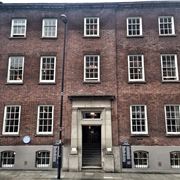 Cobden House in threesIn the press release above there's also another welcome gesture - and generous in a commercial development. Michael Ingall at Allied London says he intends to retain the public area in its present dimensions at 'The Lawns'. Good. This has become a much used and loved area of city life.
Cobden House in threesIn the press release above there's also another welcome gesture - and generous in a commercial development. Michael Ingall at Allied London says he intends to retain the public area in its present dimensions at 'The Lawns'. Good. This has become a much used and loved area of city life.
One of the dreams of the post-war Modernists was for 'streets in the sky', those failed pedestrian walkways that connected flats in developments such as Hulme. With Manchester House, Cloud 23, Hotel Gotham, Great John Street Hotel's cocktail roof and now No 1 Spinningfields the city seems set on course for a network of restaurants in the sky instead.
Back to Quay House.
Maybe for many people when Quay House goes, the fabulous 2009 Manchester International Festival production of It Felt Like A Kiss from Punchdrunk Theatre will be it's finest hour. Others might feel it was the fact it that the building hosted Manchester Confidential for a while - well at least we will in Manchester Confidential.
Jonathan Schofield
You can follow Jonathan Schofield on Twitter here @JonathSchofield or connect via Google+









